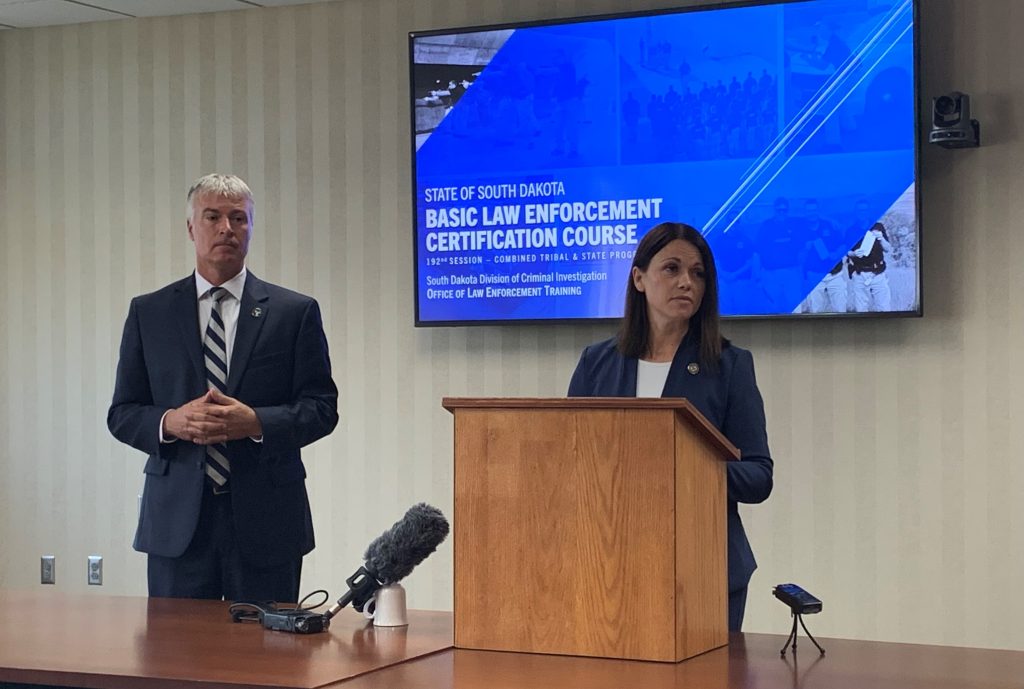Podcast: Play in new window | Download | Embed
The South Dakota Attorney General’s office is partnering with tribes located in the state to train new law enforcement officers.
It’s part of an effort to address a public safety shortage in Indian Country by keeping recruits close to home in South Dakota.
South Dakota Public Broadcasting’s Lee Strubinger reports.
A batch of law enforcement officer recruits practice a straight arm bar takedown in a gymnasium at the Mickelson Criminal Justice Center in Pierre, S.D.
Twenty-four new officers representing fifteen agencies are almost midway through the training course. Of the 24, 11 from three different tribes are slated to become tribal officers following their certification.
Often, tribal law enforcement recruits attend a similar 13-week training course hundreds of miles away in New Mexico. That’s seen as a barrier to brining in new law enforcement officers. Some say training in Pierre allows them to go home on the weekends and be around their community.
Officer Michelle Casiano-Keeble is from Sisseton Wahpeton and works for the police department.
She says the in-state training allows her to also see her children.
“Being a mother of three, it’s definitely helped me be there for my kids and still do what I want to do and pursue my dreams of being a law enforcement officer.”
Having an in-state training course dedicated to tribal officers was a priority of Gov. Kristi Noem (R-SD).
Attorney General Marty Jackley says that allows for uniform training across the state, while building local relationships for officers who will work across jurisdictions.
“Making it local makes sense because of consistency. When a deputy sheriff from a county shows up and there’s a tribal officer they’ve had the same simulator training. They’ve had the same criminal law training to know when you need to get a warrant and when you don’t in South Dakota.”
The state training course runs into September before recruits get a state law enforcement certification. Then, Jackley says there will be a special law enforcement commission class, which if approved by the Bureau of Indian Affairs, allows officers to make a federal arrest in Indian Country.

Members of the Leech Lake Band of the Ojibwe Tribe harvest rice on Mud Lake, 17 miles downstream of Leech Lake Dam.
The Confederated Salish and Kootenai Tribes joined six other tribes in defense of a new federal rule protecting their water rights in court.
The rule requires states to consider tribes’ fishing, hunting, and gathering rights while crafting water regulations.
Montana Public Radio’s Aaron Bolton reports several states want to overturn the rule.
Twelve states sued the U.S. Environmental Protection Agency over the rule, which was finalized earlier this year.
Montana is not part of the lawsuit.
Those states argue the federal government oversteps its power under the Clean Water Act and would severely limit their ability to craft water standards.
Seven tribes have filed a motion to intervene in the case.
They say the rule is key to protecting “reserved rights,” which gives tribes the ability to hunt, fish and gather on lands they ceded to the federal government through treaties.
The tribes say the rule is within the EPA’s authority as it ensures treaties are adhered to.
Members of Arizona’s congressional delegation introduced legislation Monday to secure water rights for the Navajo Nation, the Hopi Tribe, and the San Juan Southern Paiute Tribe.
The Northeastern Arizona Indian Water Rights Settlement (NAIWRSA) Act of 2024 ratifies and funds the Northeastern Arizona Indian Water Rights Settlement Agreement.
The settlement will provide reliable and safe water for the tribal communities.
It authorizes $5 billion to acquire, build, and maintain essential water development and delivery projects.
The tribes would be guaranteed access to more than 56,000 acre-feet of Colorado River water.
Get National Native News delivered to your inbox daily and stay up-to-date on the 2024 Native Vote. Sign up for our daily newsletter today.




